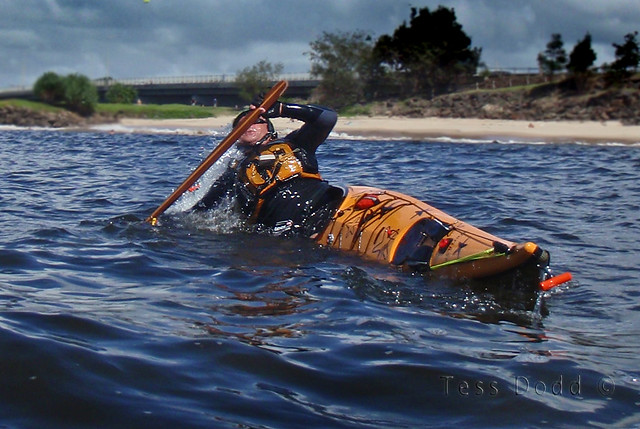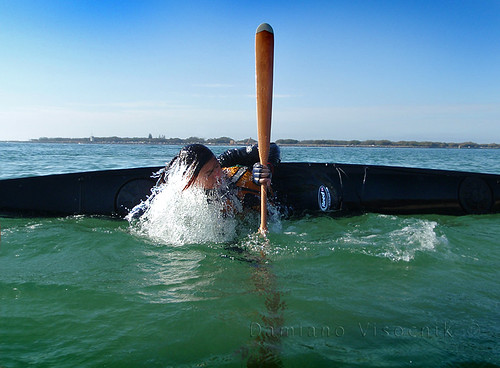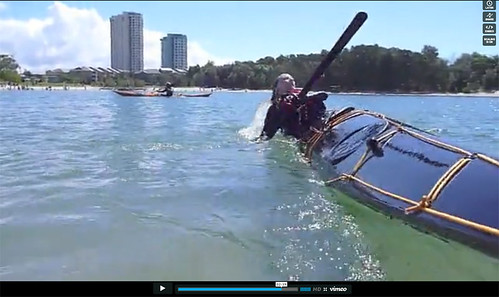Some initial adjustment was necessary to my stroke to gain the maximum benefit from these new tools.
My forward stroke no longer needed to be so high and I had to learn how to cant the Greenland paddle to achieve a quiet and efficient stroke.
Eventually I started to venture into the surf with the traditional paddles and I now find them easier to use than the big bladed Euro.
The biggest difference however came when I started rolling with a skinny paddle.
I was thought the typical CtoC kayak roll where the emphasis is on the blade and much less on kayak rotation to execute the roll.
Only now that I use traditional paddles I can notice the marked difference between a graceful roll and a forced roll.
The revelation came when a very proficient paddler, surf kayaker and roller could not execute a roll when handed one of my Aleut paddles.
Why could he not roll with my paddle when he was so good with his wing paddle?
I could not figure it out at the time but looking back at pictures of my style then and now I see what was happening.

Sea kayak instructors all over Australia teach the explosive white water style roll where momentum and support from the paddle are essential.
Once I started to roll regularly with my new skinny paddles I looked at my rolls (video footage) and noticed a problem: my paddle would end up vertically before the kayak was rolled.
Through mentoring of the selfless dedicated self taught Greenland roller Greg Schwarz I started to correct my poor style and progress into a direction where body pressure on the deck/thigh braces of the kayak is way more important than pressure on the paddle.
Slowly I gained the knowledge and confidence to roll Greenland style. I watched a lot of videos and started to notice that all good rollers executed their rolls with such grace and finesse, never rushing and never forcing their rolls.
Since there is no formally qualified Greenland technique instructor in Australia most rollers are self taught.
While self teaching has great merits often leads to bad habits if one is not referencing his/her style to the one of the masters.
One such master is Helen Wilson. Her style is incredibly graceful.
Her video might not be the most technically produced footage (some of the audio is rather erratic and hard to hear) but her explanation on how to execute Greenland rolls has helped me and my friends to correct some of our mistakes.
Helen Wilson’s video is available in Australia through :
Sydney Harbour Kayaks (NSW)
Blue Earth Paddle Sports (NSW)
Adventure Outlet (QLD)
and Fat Paddler direct for the other states.
I know that there has been resistance from some instructors in embracing the fast growing following of Greenland rolling but I assume that the reason behind is ignorance in the technique.
I have seen several videos lately where local kayakers have started to explore the use of the stick but are having the same problems I had myself: powering those rolls instead of finessing them.
It seems apparent that they are willing to try the stick but have not understood the fundamental difference between a white water roll and a Greenland Roll.
A well executed G roll will not show force or momentum. The emphasys is on controlling and rotating the kayak to come back up, not on the support offered by the paddle.
If a roll with a skinny paddle is marginal in calm waters it certainly will not work in the surf where aerated water will not offer enough resistance on the pressure applied to the paddle.
Some examples of forced rolls using a Greenland paddle:

Adventuretess in her early rolling days

source: Queensland Sea Kayak Club

I am lucky to have a dedicated group of kayakers that mentor each other with rolling and criticize and correct each other’s mistakes with the goal to gain better boat control and overall performance out of our crafts.
And here is Adventuretess a few months ago:
It looks like her style has improved...
PS Gnarlydog and Team are away on safari right now and will return to MEI Headquarter in early May...




Sounds like you had poor rolling instruction at the beginning, Dog.
ReplyDeleteThere's absolutely nothing about the Greenland stick that makes finesse rolls based on torso and leg work any easier or more natural when compared to the Euro paddles. Every good rolling instructor will tell you that you need to bring the boat under your body with your legs and lower torso not lift the body out of the water by pushing on the paddle.
There's drawback with learning the Greenland way too. Those who learn the layback roll don't develop the concept of hip snap. When it comes to something like storm roll, someone who can perform beautiful traditional rolls does not transfer anything to this new skill. Slow laybacks are not appropriate for all situations where one may need to roll.
Seems to me that properly executed C2C--hip snap, head ding, minimal reliance on the paddle--is the easiest way to convey the
Nice post and a really nice video, Gnarlydog. (Well done Adventuretess). I think that what you've observed is a very good example of a piece of equipment forcing good technique. Just like a wing paddle forces you to use good forward stroke technique, I think rolling with a GP forces you to use your body more. However, I disagree in one respect, if you're doing the C-C or screw rolls properly, there is very little force on the paddle. But you're right in that the Euro blades are more forgiving of poor technique for those rolls and they will allow you to muscle up where a GP may not. I notice that all of the pics of your (and Tess's) early rolling efforts indicate that the head is coming up early. (I've got similar pics of me too :()
ReplyDeleteI spent a few days with Helen earlier this year, doing lessons and discussing rolling theory over a quiet rum or two. It is interesting in that she discussed body shape a lot and how it affects rolls. For a paddler like me (and probably you G-Dogg!) with a big upper body, we do tend to pull our boats back down on ourselves, making the slow finessed layback rolls a little more difficult. I spent some time working on a forward finishing storm roll, which relies a lot more on an explosive knee lift (warning: never say "hip snap" to Helen!) synchronised with a powerful paddle movement. My technique is sh*te so I struggled with both types, but I did find the storm roll seemed to be better aligned to my strengths.
ReplyDeleteBtw Tess' rolling is looking amazing these days!
We had Helen here for our last symposium, and she is coming again for the next one. She`s by far the best teacher of
ReplyDeleteG style rolling that I have seen and her tech and teaching managed to get almost everyone rolling with grace . I agree with you Gnarly, these rolls are effortless and even work well in rough water.
Hi Gnarly,
ReplyDeleteAnother really good post and it is great to see how far Tess's rolls have come. As for Helen Wilsons DVD's they can also be purchased online from Greenland Downunder at http://www.greenlanddownunder.com.au , that's right we finally have a web site, please check it out and let me know what you think.
Regards,
Wayne
If you learn how to roll properly, you should not need the “extra support” of the Euro blade, to come up. In turbulent water, you can not always count on “extra support” and only a good technique will get you back up. I agree with Haris, you were probably poorly taught at the beginning to make a statement like this. As far as I am concern, rolling is about coming up at any given time and in all kind of water. Euro or Greenland shouldn’t matter other than looking good on camera, if you come up at ALL TIMES, you know how to roll. Style is one thing, being successful is most important.
ReplyDeleteSteeve
My early rolling learning was admittedly bad.
ReplyDeleteInitially taught in a too large group where the instructor could not address the student’s basic mistakes resulted in a very poor form. Followed by further instructions by an ignorant (although certified) instructor that could not correct my lame form I ended up with the focus of my roll on my paddle instead of the knee/thigh/body rotation to bring myself up.
To aspiring rollers I would say: just because your teacher is an instructor it does not mean he/she knows how to TEACH the basic mechanics of rolling.
The local instructor that finally got me rolling knew how to teach and was able to address each individual student personally with tailored instructions to cater for one’s flexibility, body type and potential fears.
If I had to do over again I would forego large classes. I believe that rolling requires personal attention from a person that understands rolling, not just somebody that is an instructor that really can only regurgitate textbook knowledge.
Style and being successful are not mutually exclusive.
ReplyDeleteHaving a graceful, effortless roll regardless of paddle or conditions is the aspiration of any genuine kayaker. The Greenland paddling culture simply promotes as a core kayaking skill.
I acquired a GP about a year ago and was bitten by the Greenland bug, as a result my confidence and enjoyment in the kayak has grown immensely.
Looking good on camera means everything!
Great post Gnarly.
You're dead right there, GD. A really good instructor is priceless.
ReplyDeleteI was a bit surprised that you mention the C-to-C roll.
ReplyDeleteIn white-water paddling C-to-C roll was in fashion back in the '70s but has been out of fashion for decades. Nowadays almost nobody (except for ERA) teaches or promotes the C-to-C roll.
The roll most commonly taught and used would be the sweep roll.
Also the back deck roll: http://worldkayakblogs.com/kenwhiting/2007/12/04/the-back-deck-roll/
Not disagreeing about greenland rolls just saying that comparing greenland to C-to-C is a bit pointless in 2011.
Love your blog.
ReplyDeleteRegarding the greenland roll, I would say that the artic regions are indeed the most demanding Research Department on Earth.
Eskimos didn't roll for the sake of it. They had to survive in the toughest natural environment.
European style kayaks and paddles would have been considered insane. Wet exits out there are not an option: they mean death. And a hunter's death could mean hunger and more deaths.
So we can say without any doubt that the greenland techniques ARE the best, in the absolute sense of the term. Man vs Wild, without the bullshit, in other words.
Having said that - I assume there are no whale or narval hunters reading your blog - it's great to be among the happy fews who live in a world where one is able to try and adopt many different techniques for the fun of it.
As long as we keep in mind that nature will always beat our sophisticated labs and technologies in the long run, of course.
This is why I like the humble spirit of your blog. It rocks, keep on rollin'...
Oliver, thank you for the compliment and the very thoughtful comment. We are lucky indeed that we can consider kayaking a fun activity that allows us to experiment with techniques solely for the pure enjoyment of it.
ReplyDeleteBuongiorno, sono un principiante, vorrei sapere se i rotoli dono lefati a un tipo di kayak o sono possibili con qualsiasi kayak.
ReplyDeleteGrazie
E` possibile rotolarsi in qualsiachi kayak se si riesce a rimanere attaccati al kayak. Quelli senza pozzetto non sono adatti. Quelli con pozzetto molto grande e senza contatto per le gambe/ginocchia sono molto difficili/quasi impossibili per un principiante.
DeleteI kayak migliori sono quelli con poco volume con pozzetto stretto dove si riesce a rimanere seduti quando ci si ribalta
Ti ringrazio per la risposta.Grazie
DeleteGraie per la risposta.
ReplyDeleteBuondì, vorrei porre un quesito che non riesco a chiarirmi: sento spesso parlare della ginocchiata/colpo di coscia, mi chiedo se il colpo d'anca è una tecnica diversa ose le due cose sono un tutt'uno. Ringrazio e sono grato a chiunque possa darmi delucidazioni sull'argomento.
ReplyDeletePer dire la verita` questa teoria del colpo (movimento rapido) non mi e`mai stato bene. Sia possibile che possa essere utile con kayak piccoli usati dui fiumi ma secondo me in uno di piu` di 5 metri la tecnica non e` ideale. Preferisco la tecnica dello "sculling" dove il movimento continuo avanti/indietro della pagaia mi da la resistenza sufficiente per tirarmi su dall'acqua, e non ho la possibilita di fallire quel benedetto "colpo" a cui tanto si allude. Se una passata con la pagaia non basta, ne faccio un'altra, e magari una terza fino a che non sono di nuovo completamante verticale, uscito dall'acqua. Funziona a meraviglia :-)
ReplyDelete